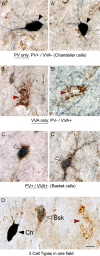The Number of Chandelier and Basket Cells Are Differentially Decreased in Prefrontal Cortex in Autism
- PMID: 28122807
- PMCID: PMC6676950
- DOI: 10.1093/cercor/bhw349
The Number of Chandelier and Basket Cells Are Differentially Decreased in Prefrontal Cortex in Autism
Abstract
An interneuron alteration has been proposed as a source for the modified balance of excitation / inhibition in the cerebral cortex in autism. We previously demonstrated a decreased number of parvalbumin (PV)-expressing interneurons in prefrontal cortex in autism. PV-expressing interneurons include chandelier (Ch) and basket (Bsk) cells. We asked whether the decreased PV+ interneurons affected both Ch cells and Bsk cells in autism. The lack of single markers to specifically label Ch cells or Bsk cells presented an obstacle for addressing this question. We devised a method to discern between PV-Ch and PV-Bsk cells based on the differential expression of Vicia villosa lectin (VVA). VVA binds to N-acetylgalactosamine, that is present in the perineuronal net surrounding some cell types where it plays a role in intercellular communication. N-acetylgalactosamine is present in the perineuronal net surrounding Bsk but not Ch cells. We found that the number of Ch cells is consistently decreased in the prefrontal cortex of autistic (n = 10) when compared with control (n = 10) cases, while the number of Bsk cells is not as severely affected. This finding expand our understanding of GABAergic system functioning in the human cerebral cortex in autism, which will impact translational research directed towards providing better treatment paradigms for individuals with autism.
Keywords: autism; basket cells; chandelier cell; parvalbumin; prefrontal cortex.
© The Author 2016. Published by Oxford University Press. All rights reserved. For Permissions, please e-mail: journals.permissions@oup.com.
Figures




Similar articles
-
Chandelier Cartridge Density Is Reduced in the Prefrontal Cortex in Autism.Cereb Cortex. 2021 May 10;31(6):2944-2951. doi: 10.1093/cercor/bhaa402. Cereb Cortex. 2021. PMID: 33527113 Free PMC article.
-
Reduction in parvalbumin expression not loss of the parvalbumin-expressing GABA interneuron subpopulation in genetic parvalbumin and shank mouse models of autism.Mol Brain. 2016 Jan 27;9:10. doi: 10.1186/s13041-016-0192-8. Mol Brain. 2016. PMID: 26819149 Free PMC article.
-
The Number of Parvalbumin-Expressing Interneurons Is Decreased in the Prefrontal Cortex in Autism.Cereb Cortex. 2017 Mar 1;27(3):1931-1943. doi: 10.1093/cercor/bhw021. Cereb Cortex. 2017. PMID: 26922658 Free PMC article.
-
Enhanced accumulation of N-terminally truncated Aβ with and without pyroglutamate-11 modification in parvalbumin-expressing GABAergic neurons in idiopathic and dup15q11.2-q13 autism.Acta Neuropathol Commun. 2020 Apr 28;8(1):58. doi: 10.1186/s40478-020-00923-8. Acta Neuropathol Commun. 2020. PMID: 32345355 Free PMC article.
-
Parvalbumin and parvalbumin chandelier interneurons in autism and other psychiatric disorders.Front Psychiatry. 2022 Oct 12;13:913550. doi: 10.3389/fpsyt.2022.913550. eCollection 2022. Front Psychiatry. 2022. PMID: 36311505 Free PMC article. Review.
Cited by
-
Decreased number and increased activation state of astrocytes in gray and white matter of the prefrontal cortex in autism.Cereb Cortex. 2022 Oct 20;32(21):4902-4912. doi: 10.1093/cercor/bhab523. Cereb Cortex. 2022. PMID: 35212358 Free PMC article.
-
Lateralized Decrease of Parvalbumin+ Cells in the Somatosensory Cortex of ASD Models Is Correlated with Unilateral Tactile Hypersensitivity.Cereb Cortex. 2022 Jan 22;32(3):554-568. doi: 10.1093/cercor/bhab233. Cereb Cortex. 2022. PMID: 34347040 Free PMC article.
-
Altered synaptic ultrastructure in the prefrontal cortex of Shank3-deficient rats.Mol Autism. 2020 Nov 17;11(1):89. doi: 10.1186/s13229-020-00393-8. Mol Autism. 2020. PMID: 33203459 Free PMC article.
-
The valproic acid rat model of autism presents with gut bacterial dysbiosis similar to that in human autism.Mol Autism. 2018 Dec 10;9:61. doi: 10.1186/s13229-018-0251-3. eCollection 2018. Mol Autism. 2018. PMID: 30555669 Free PMC article.
-
Gestational iron deficiency affects the ratio between interneuron subtypes in the postnatal cerebral cortex in mice.Development. 2023 Oct 15;150(20):dev201068. doi: 10.1242/dev.201068. Epub 2023 Mar 3. Development. 2023. PMID: 36805633 Free PMC article.
References
-
- Blazquez-Llorca L, Garcia-Marin V, DeFelipe J. 2010. GABAergic complex basket formations in the human neocortex. J Comp Neurol. 518:4917–4937. - PubMed
-
- Bruckner G, Brauer K, Hartig W, Wolff JR, Rickmann MJ, Derouiche A, Delpech B, Girard N, Oertel WH, Reichenbach A. 1993. Perineuronal nets provide a polyanionic, glia-associated form of microenvironment around certain neurons in many parts of the rat brain. Glia. 8:183–200. - PubMed
Publication types
MeSH terms
Substances
Grants and funding
LinkOut - more resources
Full Text Sources
Other Literature Sources

